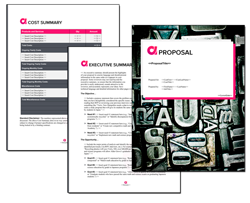What is the Operating Environment chapter used for?
Proposal Kit Professional Bundle adds more design themes, all six Contract Packs,
a project management library, and Expert Edition software.

Illustration of Proposal Pack Architecture #4
We include this Operating Environment chapter template in every Proposal Pack, along with thousands more. You assemble this chapter with others in various combinations to create custom-tailored business proposals, plans, reports, and other documents. Proposal Packs apply custom visual designs to the templates, giving the final documents a consistent professional finish.
 DOWNLOADABLE, ONE-TIME COST, NO SUBSCRIPTION FEES
DOWNLOADABLE, ONE-TIME COST, NO SUBSCRIPTION FEES
Overview of the Operating Environment Chapter
The Operating Environment chapter is an important part of a business proposal that helps to set the context for the product or service being offered. This chapter is specifically designed to describe the conditions under which a product or an organization operates. Understanding the operating environment is crucial for potential clients or partners, as it gives them insight into the external factors that could impact the success or functionality of the proposed solution.
How is the Operating Environment Chapter Used?
In a business proposal, the Operating Environment chapter is used to provide a detailed description of the physical, social, economic, and technological conditions surrounding the product or service. This may include information on the regulatory environment, economic conditions, competitive landscape, technological advancements, and social factors that influence how the product or service functions. This chapter helps the reader understand the specific challenges and opportunities the product or service may encounter in its operational setting.
What is Included in the Operating Environment Chapter?
The content of the Operating Environment chapter typically includes:
- Regulatory Factors: Describes any laws, regulations, or guidelines that affect how the product or service is developed, used, or sold.
- Economic Conditions: Outlines the economic environment, including market trends, economic stability, and the general economic climate that could impact operations.
- Technological Landscape: Provides details on the current technology that supports the product or service, as well as emerging technologies that could affect its future development.
- Competitive Analysis: Examines the competitive landscape, identifying key competitors and their influence on the market.
- Social Factors: Considers social aspects such as demographics, cultural trends, and consumer behaviors that might influence the acceptance and success of the product or service.
Use Case Examples for the Operating Environment Chapter
- Automation: Proposal for a new automated system where the chapter details the technological readiness of the industry and regulatory standards affecting automated solutions.
- Manufacturing: In a proposal for a manufacturing facility, the chapter can explain the economic factors influencing manufacturing costs and the availability of skilled labor.
- Fabrication: The proposal might outline the physical conditions required for a fabrication plant and the impact of environmental regulations on operations.
- Physical Items: For products, this chapter could describe the logistical and environmental conditions necessary for the storage and transportation of physical goods.
- Technical: For technical services, the chapter might discuss the technological infrastructure needed to support the services and any technological challenges or barriers.
Key Takeaways
- The Operating Environment chapter is crucial for setting the context in which a product or service operates.
- It addresses regulatory, economic, technological, competitive, and social factors.
- This chapter helps potential clients or partners understand external influences that might impact the product's or service's functionality and success.
- It is and can be tailored to suit proposals across various industries such as automation, manufacturing, and technical services.
- Properly describing the operating environment can significantly enhance the persuasiveness and effectiveness of a business proposal.

Illustration of Proposal Pack Symbols #9
 What Our Clients Say
What Our Clients SayA simple software tool to meet complex "Request for Proposal" requirements. I’ve used this on a few proposals, and haven’t found an easier solution."
ISC Services LLC
 4.7 stars, based on 845 reviews
4.7 stars, based on 845 reviewsRelated Chapters
Document Layouts Using the Operating Environment Chapter

The Operating Environment chapter and other chapters are integrated into a Word document as illustrated here in the Proposal Pack Elegant #8 design theme. There are hundreds of design themes available, and every design theme includes the Operating Environment chapter template.
A proper business proposal will include multiple chapters. This chapter is just one of many you can build into your proposal. We include the complete fill-in-the-blank template in our Proposal Pack template collections. We also include a library of sample proposals illustrating how companies in different industries, both large and small, have written proposals using our Proposal Packs. This template will show you how to write the Operating Environment.
We include a chapter library for you to build from based on your needs. All proposals are different and have different needs and goals. Pick the chapters from our collection and organize them as needed for your proposal.
Using the Proposal Pack template library, you can create any business proposal, report, study, plan, or document.
 Ian Lauder has been helping businesses write their proposals and contracts for two decades. Ian is the owner and founder of Proposal Kit, one of the original sources of business proposal and contract software products started in 1997.
Ian Lauder has been helping businesses write their proposals and contracts for two decades. Ian is the owner and founder of Proposal Kit, one of the original sources of business proposal and contract software products started in 1997.By Ian Lauder
 Published by Proposal Kit, Inc.
Published by Proposal Kit, Inc.


 Cart
Cart
 Facebook
Facebook YouTube
YouTube X
X Search Site
Search Site